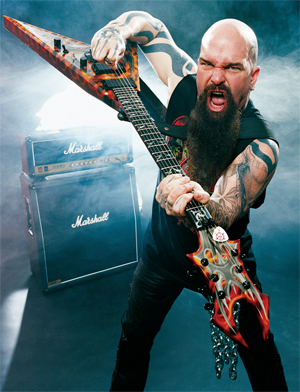Kerry King: King of Pain


Originally printed in Guitar World, December 2007
All hail Marshall's new Kerry King signature amp, the 2203KK JCM800! The brutal tones that made Slayer famous are now available to mere mortals.
Produced from 1981 until l 1990, the Marshall JCM800 defined the sound of Eighties metal. Everyone from classic rockers like Judas Priest to glam hair-metal bands appeared onstage with JCM800 backlines, but one band in particular—Slayer—used its JCM800 2203 100-watt heads to spawn new extremes of distortion, establishing the sound of the next generation of hardcore, thrash and death metal guitarists.
The Marshall JCM800 2203 provided the muscle behind the massive rhythm tones of classic Slayer albums like Hell Awaits, Reign in Blood and Seasons in the Abyss, and it remains the backbone of the onstage backline for guitarists Kerry King and Jeff Hanneman. One particular 2203 head that King calls “the Beast” is unique among all others. Acquired by King in the mid Eighties, it became his main live and recording amp.
“That amp annihilates all the others,” King says. “It’s as if Satan reached up, touched that head himself and conspired with Jim Marshall to create something miles above the rest. Its sound is Herculean. It sounds 10 times bigger than other amps like it.”
While Slayer were in England during their 2005 European tour, Nick Bowcott, Marshall Amplification’s U.S. product manager (and a Guitar World associate editor), asked King if Marshall’s technicians could borrow the Beast in order to thoroughly analyze the head and create a Kerry King signature amp. King complied, and the 2203KK JCM800 is the result. After nearly two years of development this amp is finally available, and it’s generated a considerable buzz among Marshall aficionados and Slayer fans alike.
“I know and trust the guys at Marshall,” King says. “I sent the Beast over there once before to have Jim Marshall sign it. When the technicians checked it out, they discovered that this particular amp was the ‘golden child.’ Apparently it was one of the rare ones, where all the parts and variances were perfect for my sound.”
Get The Pick Newsletter
All the latest guitar news, interviews, lessons, reviews, deals and more, direct to your inbox!
“That amp hasn’t been modified in any way, shape or form,” Bowcott says. “It’s completely stock. Component drift and tolerance deviations have made that amp something special and—as Kerry sometimes says—the ‘golden child’ when it comes to his trademark tone. Back in the Eighties, you couldn’t enforce the sort of tolerances that we demand from our suppliers today, which is plus or minus one percent. Back then, the plus-or-minus percentage was much higher. As a result, Kerry’s amp sounds different from a lot of other JCM800s made in the mid Eighties.” Originally supplied with a quartet of 6550 tubes, King’s Marshalls are beefed up with heavier duty KT88 tubes. “They have a nice, fat low end that Kerry loves,” Bowcott says. “Those tubes add a lot to his vibe and make his sound even bigger.”
While Marshall’s Slash and Zakk Wylde signature amps were essentially reissues of the original JCM 2555 Silver Jubilee and JCM800 2203 heads, respectively, the Marshall 2203KK JCM800 Kerry King head is a unique new product. “This is an exact duplicate of the Beast,” Bowcott says. “It’s a much more aggressive animal than our current 2203 reissue, which is based on the early Eighties circuit.”
The amp also includes new features not available on any other Marshall amp. A special EQ setting called “Assault” replicates the unique midrange curve generated by King’s Boss RGE-10 graphic equalizer, and a studioquality noise gate with an expander circuit provides natural-sounding gating. An on/ off switch named “the Beast” activates both of these features, which live in front of the 2203KK’s preamp.
“Part of the secret to the Slayer sound is what Kerry and Jeff do to the front end of their amps,” Bowcott says. “Kerry used his 10-band graphic EQ to push the front end of the amp harder. What’s interesting is that 99 percent of players out there think that you need to scoop the mids out to get Slayer’s guitar tone. Kerry does the exact opposite—he boosts the mids. A scoop is a smile,” he explains, referring to the shape of a scooped-mid EQ curve. “You can’t have a smile when you’re playing Slayer’s music! His EQ curve is a fairly radical frown, which makes more sense.”
Fubg gave Marshall his RGE-10, dialed in to the exact EQ curve that he uses. Marshall’s technicians duplicated the setting in a circuit whose sensitivity is controlled by the Assault knob. “The only setting on the RGE-10 that Kerry would mess with is the level slider,” Bowcott explains. “The Assault control goes from zero to 10 to duplicate the function of the level slider; it just controls how much kick the EQ curve has. If you put the amp’s signal through an oscilloscope and turned up the intensity of the Assault control, the curve it displayed would look like someone giving you the finger.”
- You can either add more or less of my tone,” adds King. “You can’t adjust all 10 EQ bands individually. My chunk comes from those boosted mids.”
- Hitting the front end of any amp with boosted midrange EQ can result in unwanted noise and feedback problems, especially when playing at high volume. To ensure that the Beast circuit remains tight and noise-free, Marshall’s engineers developed a special noise gate circuit with a threshold control.
Most noise gates completely kill the sound once it drops below a certain threshold,” Bowcott says. “This noise gate has an ultrafast expander circuit that’s similar to what you’ll find in a studio-quality noise reduction unit. It will work extremely fast during tight, precise staccato rhythms, giving you those desired ‘holes of silence.’
When it comes to sustained notes, though, the expander gradually attenuates the signal by following the dynamics of the note, giving you a much more natural-sounding gating that won’t prematurely cut off the end of a note or chord that you want to ring.”
“I still use an external gate in my rig for all of my other electronic stuff, like my wireless unit,” King says. “But I don’t need to put the EQ, noise gate or any other outboard equipment directly in front of my amp any more. This amp delivers my sound right out of the box, without anything else. I just plug into it and play.”
In addition to these new features, the Kerry King head is distinguished by a subtle custom graphic design inspired by King’s tattoos, and King’s signature (placed directly below that of Jim Marshall) on the control plate. Marshall completed the first prototypes of the 2203KK JCM800 in December 2005, when Slayer were in the studio recording Christ Illusion. King used the prototype as his main amp on the album, and when Slayer hit the road in June 2006, he brought several prototypes along with him to give the amps the ultimate road test, Slayer style.
I’ve been playing with it on the road for almost 18 months,” King says. “Before Marshall even started making the production models they wanted to make sure that the amp was going to stay together and not have reliability issues.”
“Kerry is the best road tester on the planet, because Slayer tour incessantly,” Bowcott says. “He’s still using the first three prototypes that we gave him. They’re now the only amps in his rig, and Jeff has a few prototypes in his, as well. Kerry hasn’t had any problems with them. We’ve done four runs of the amps now and sent amps from each run to Kerry.”
“Before Marshall even started making the production models they wanted to make sure that the amp was going to stay together and not have issues on tour,” King says. “I’ve been running three of the prototype heads at once, and I have one or two backups that I’ve never had to use. The production models are exactly the same as the prototypes. If for some reason my gear doesn’t show up or gets stuck in customs, I can go to any music store, buy some heads and do a show.”
Marshall is not offering a special cabinet to go with the head; instead, guitarists are encouraged to make their own speaker choices. King uses the heads with Marshall Mode IV cabinets. “This head is made to sound big,” King says. “The biggest sound I can get with a Marshall cabinet comes from the Mode IV cabs.” In King’s rig, the three heads are hooked up to six cabinets in a staggered configuration, with the top cabinet diagonal from a bottom cabinet. “If you turn two of the heads off, it completely changes the tone,” King explains. “I can play one individually and go, ‘That sounds cool, but it just doesn’t have that fuckin’ ugh!’ I’ll dial each one to where I think it’s cool, and when I put them all together it sounds gargantuan.”
While Marshall’s previous signature amps for Slash and Zakk Wylde were limited-edition models, King demanded that Marshall make his amp a standard production item. With a street price of $1,899, the amp is also more affordable than Marshall’s limited edition offerings.
“That was the most important thing to me,” King says. “I didn’t want to make a limited- edition amp. When I tried to get one of Zakk’s amps, I called Marshall way early in the game and said, ‘Zakk’s my friend. I don’t care how much you charge me for it—I want it.’ But I couldn’t get one! If it was that hard for someone who is connected to all these fuckers, I wondered how difficult it was for the kids. The only way you can get one of Zakk’s signature amps is on the secondhand market, by paying two times what it’s worth. I told Marshall that if they wanted to make a limited-edition amp, I wasn’t interested. Kids want to emulate their heroes. If the amp isn’t affordably priced, you’re missing the whole point.
“It would be cool if they wanted to do a limited run of maybe 300 with some crazy graphic on it that would be numbered and signed,” he considers. “I’m not against that. But a product is a product. I want the kids to be able to enjoy it. So many of my friends in the biz have already ordered them.”
As the third guitarist to be honored with a Marshall signature amp, Kerry King enjoys a rare distinction in Marshall history. According to Bowcott, the guitarist has rightfully earned that recognition. “Slayer and Marshall are pretty much synonymous,” he says. “They’ve arguably been one of Marshall’s best and most consistent billboards. They’ve always had a minimum of 24 Marshall cabinets onstage, whenever possible. Right now, they have a total of 58: a wall of 18 on each side and two hanging inverted crucifixes configured from 11 cabs each.
“Kerry King is a consummate professional,” he adds. “He’s been there with us every step of the way on this project, and he’s always been a pleasure to work with. He’s become firm friends with Jim Marshall. He may look intimidating, but he always treats his fans and peers with respect.”
King is equally honored and humbled by Marshall’s acknowledgement of his contributions to the company’s success. “As far as I’m concerned, Jim Marshall is the ultimate rock star,” he says. “He made all of us sound better. It’s an incredibly unique honor to have my signature appear on an amplifier head next to his.”
“If you’ve ever wondered what unobtanium looks like in amp form, this is it”: Played and revered by Stevie Ray Vaughan, Carlos Santana, and John Mayer, Dumble amps have an almost mythical reputation. But what's all the fuss really about?
“For the price, it’s pretty much unbeatable”: Harley Benton JAMster Guitar review










